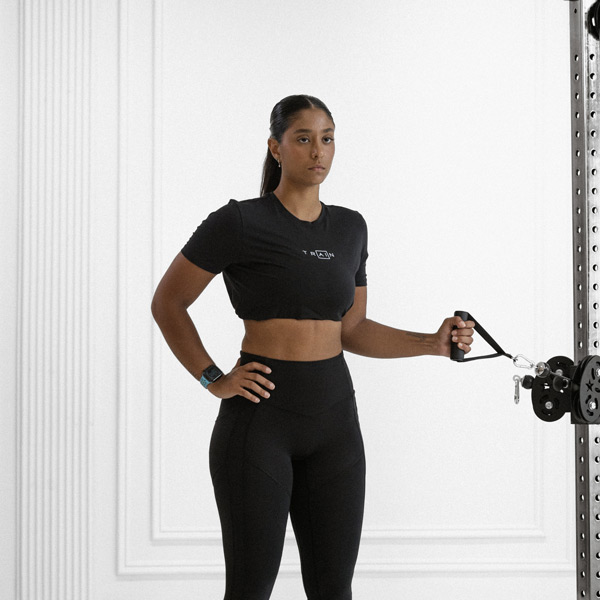Cable External Shoulder Rotation
Cable external shoulder rotation isolates the rotator cuff to build shoulder stability and prevent injuries; commonly used in rehab, warm-ups, and shoulder health programs.
About Exercise
Equipment
Single Cable Machine
Difficulty
2/5 • Beginner
Primary Muscle Groups
Shoulders
Secondary Muscles
Traps, Obliques
Popularity Score
7
Goals
Training Style
Setup Requirements
Requires Rack
No
Requires Bench
No
Requires Spotter
No
Space Needed
Small
Noise Level
Low
Muscle Breakdown
View Muscle MapShoulders
10/10Rear Delts
Traps
4/10Mid Traps
Obliques
3/10External Obliques
Programming
Typical Rep Range
10-15 reps
Rest Between Sets
60-90 seconds
How to Perform
Stand sideways to a cable machine with the pulley at elbow height and a single handle attached. Grip the handle with the far hand, elbow bent at 90 degrees and tucked to your side, forearm across your body.
- Engage your core and keep your torso stable.
- Exhale and rotate your shoulder to pull the handle outward, keeping your elbow fixed at your side.
- Pause briefly when your forearm is perpendicular to your body.
- Inhale and slowly return the handle across your body to the start position.
- Switch sides after completing reps on one arm.
Coaching Tips
Form Cues
- Elbow glued to side
- Rotate from shoulder only
- Keep forearm parallel to ground
- No shrugging
- Core tight
Breathing
Inhale during the return to starting position; exhale as you rotate outward.
Tempo
2-1-2
Range of Motion
Rotate from forearm across the body to perpendicular away, with elbow fixed at side and no torso movement.
Safety
Safety Notes
- Use light weight only
- Stop if shoulder pain occurs
- Avoid if acute rotator cuff injury
- Consult professional for rehab
- Maintain strict form to prevent strain
Spotting
Spotting not required; focus on self-controlled movement with light loads.
Common Mistakes
- Using momentum to swing
- Allowing elbow to flare out
- Twisting torso
- Shrugging shoulders
- Incomplete range
When to Avoid
- Rotator cuff tears
- Shoulder tendonitis
- Frozen shoulder
- Recent shoulder surgery
- Acute impingement
Flexibility Needed
- Adequate shoulder external rotation ROM
- Scapular stability
Build Up First
- Basic posture awareness
- Familiarity with cable machines
Also known as
Cable Shoulder External Rotation, Standing Cable External Rotation
Found this helpful?
Share your thoughts or help us improve this guide.
Similar Exercises

Cable Internal Shoulder Rotation
Single Cable Machine
Shoulders

Dumbbell Cuban Shoulder External Rotation
Dumbbells
Shoulders

Resistance Band Shoulder External Rotation
Bands
Shoulders

Dumbbell Side Lying External Shoulder Rotation
Dumbbells
Shoulders

Dumbbell Side-Lying Shoulder Internal Rotation
Dumbbells
Shoulders

Dumbbell Supine Shoulder Internal Rotation at 90 Degrees
Dumbbells, Flat Bench
Shoulders

Cable Face Pull

Single Cable Machine, Rope Cable Attachment
Shoulders

Cable Upright Row

Single Cable Machine, Bar Cable Attachment
Shoulders

Dumbbell Rotational Row
Dumbbells, Flat Bench
Lats
Cable Prone Face Pull
Single Cable Machine, Rope Cable Attachment
Shoulders


subscribe to our newsletter
Contact Us
hello@trainfitness.aiFind Us
130 Spadina Avenue, Toronto,
Ontario, M5V 0H4, Canada
©2025 All Rights Reserved
